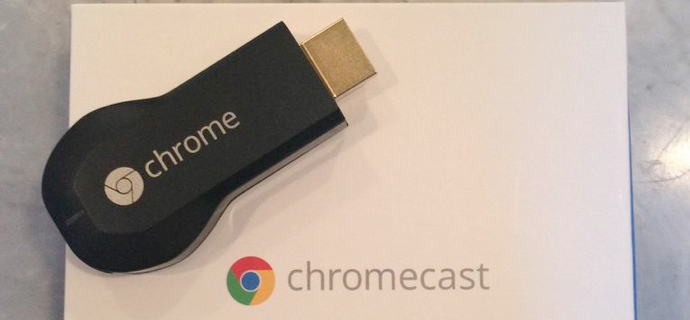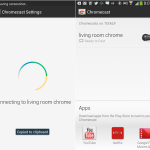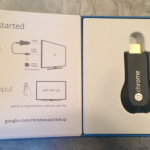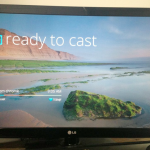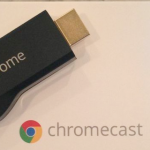TV has been one of those mediums that is prime for disruption. But even after several attempts by some of the big guys – Apple TV, Google TV, Samsung’s Smart TV – and a couple of new entrants (Roku, Slingbox, Boxee), we haven’t really seen a true evolution of the ‘boob tube’. The most disruptive platform for the TV has ironically not been a TV solution at all, but another screen entirely – our laptops, tablets and smartphones. Google knows this, which is why they recently introduced a $35 TV-streaming dongle that could change everything.
Chromecast is a small piece of hardware weighing only 34 grams and is just bigger than a USB stick at just 72mm.
The dongle basically disappears behind your TV set when you connect it to an HDMI port. Newer televisions with HDMI 1.4+ will benefit from less cord clutter behind the screen as this type of port will connect both Chromecast to the input and also power the dongle. Otherwise, you’ll have to use the provided USB power cable and power adapter to either plug Chromecast into a USB port, or into the wall to give it some juice. If your TV is cramped in the back, or if your ports are too close together, Google also provides an HDMI extender in the box.
For $35, this small piece of hardware really packs a punch. Equipped with a Marvell DE3005-A1 CPU, 512MB RAM and 2GB of storage, Chromecast is a TV-streaming dongle that has the capability to output a resolution of up to 1080p, with options to stream 480p and 720p depending on your network speed. Setup took me three minutes after unboxing. Once Chromecast is plugged into your TV, you use the Chromecast Android, PC or Mac app to give it a name, configure your Wi-Fi and you are ready to ‘cast’.
Chromecast basically does two things: content streaming and mirroring. Content streaming is extremely limited as there’s only a number of Chromecast integrated apps available, namely Netflix, YouTube, Google Music and Movies. Apps that currently support Chromecast offer a cast button that triggers the content to be streamed directly from the dongle, rather than playing it on your laptop, tablet or smartphone. This feature is very similar to Apple’s AirPlay and is just as easy to use. Many other applications, such as Hulu Plus, Pandora and HBO Go are already expected to join the list of apps and I believe this is the beginning of developer support using the Chromecast SDK.
But the fact that only a handful of applications are supported at this time (mostly USA only apps) shouldn’t be a deterrent. The real power in Chromecast is the ability to cast anything from Chrome to your TV by mirroring what’s in a Chrome browser tab. To do this, you need to first install the beta Chromecast extension in Chrome. Once this is done, you can mirror anything in the tab to your TV, including streaming video – which also uses the speakers in your TV. As Chrome also allows you to drag and drop local media into the browser tab, you can also open MP4, AVI, MKV and MP3 files on Chromecast.
After spending the last five days watching content on my TV through Chromecast, I have to say that I’m hooked. I’ve been an early cord-cutter and have tried numerous alternatives to cable to try to get the content that I want, when I want. What I like about Chromecast is its simplicity and the fact that it just works. There’s no clunky interface to wade through. No remote that gives up on you after a couple of months. It’s just you, your laptop or tablet, and one click to content.
With reliable content streaming and mirroring for only $35 it’s easy to see why these devices sold out in minutes after being released in the United States, thus already commanding a big price on eBay. Analytics company comScore indicates that cord-cutting is on the rise here in Canada, showing 16% of Canadians having already ditched traditional TV, so I would expect that when Chromecast is officially available North of the border they won’t last long on our shelves either.
However, in an email to us Google noted that availability of Chromecast in Canada has “no timeline yet. Fingers crossed won’t be long.”


